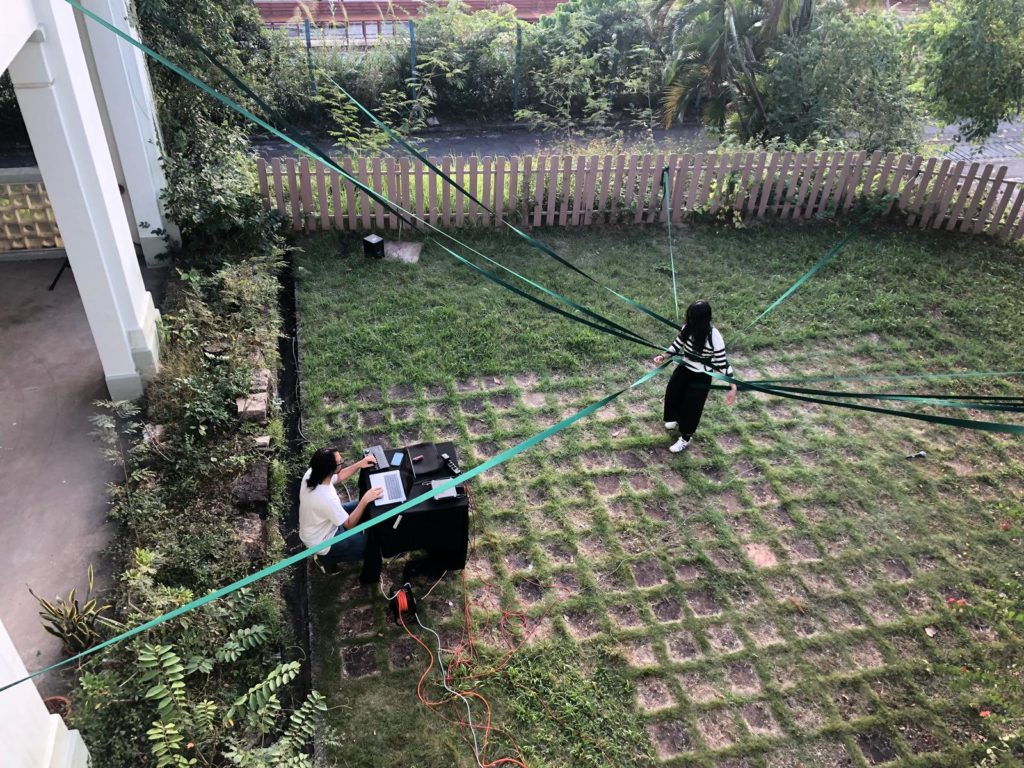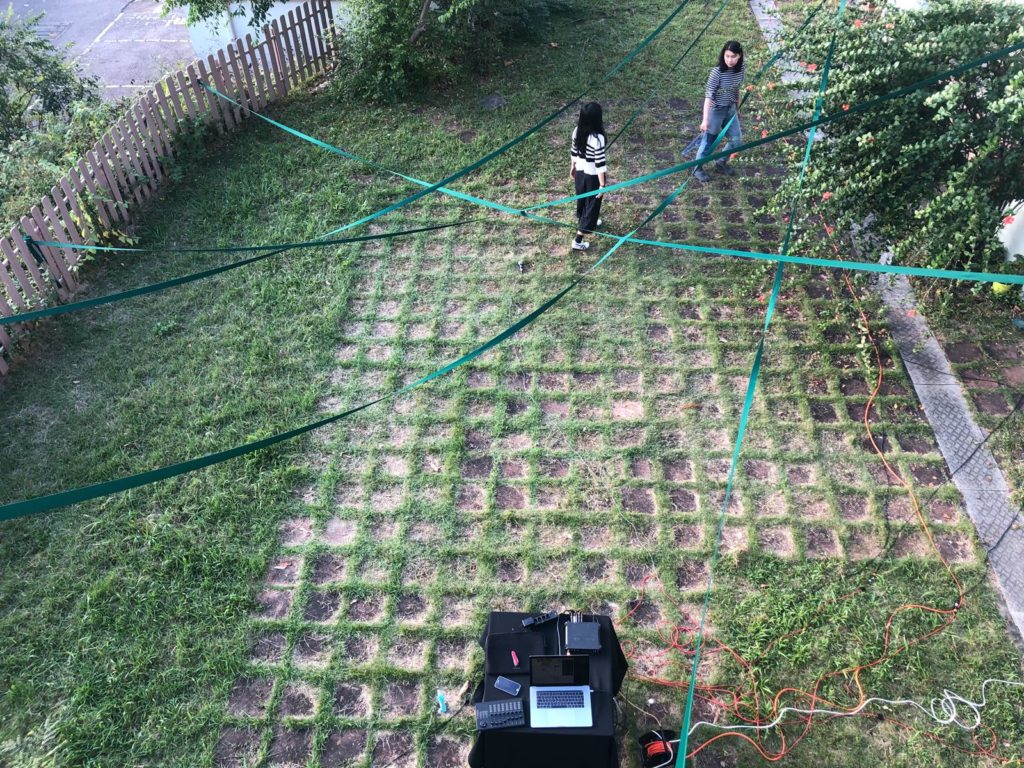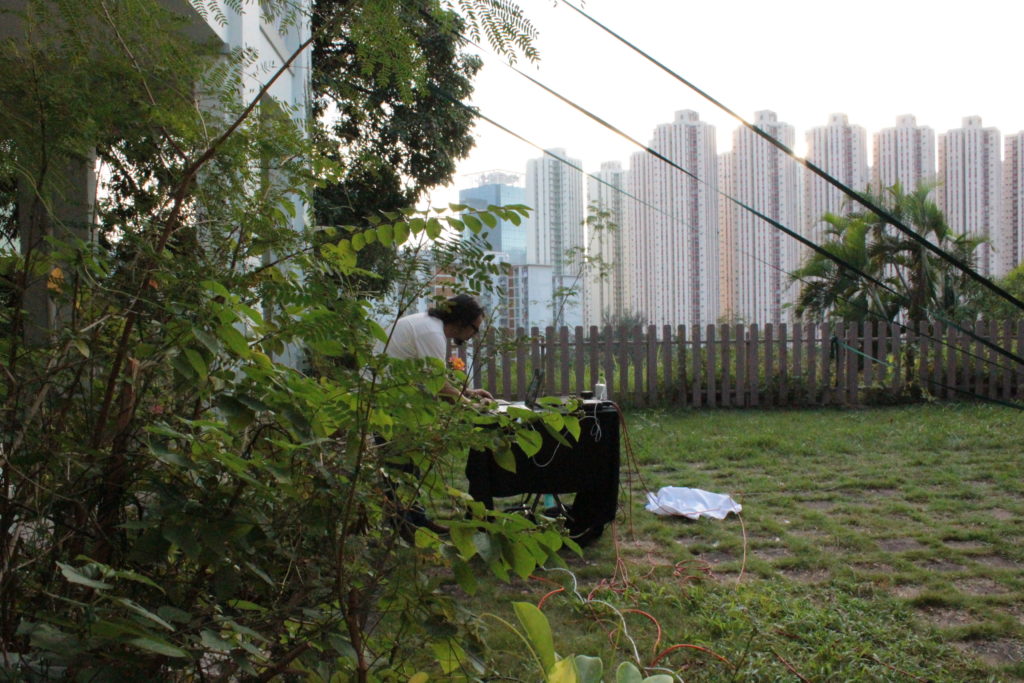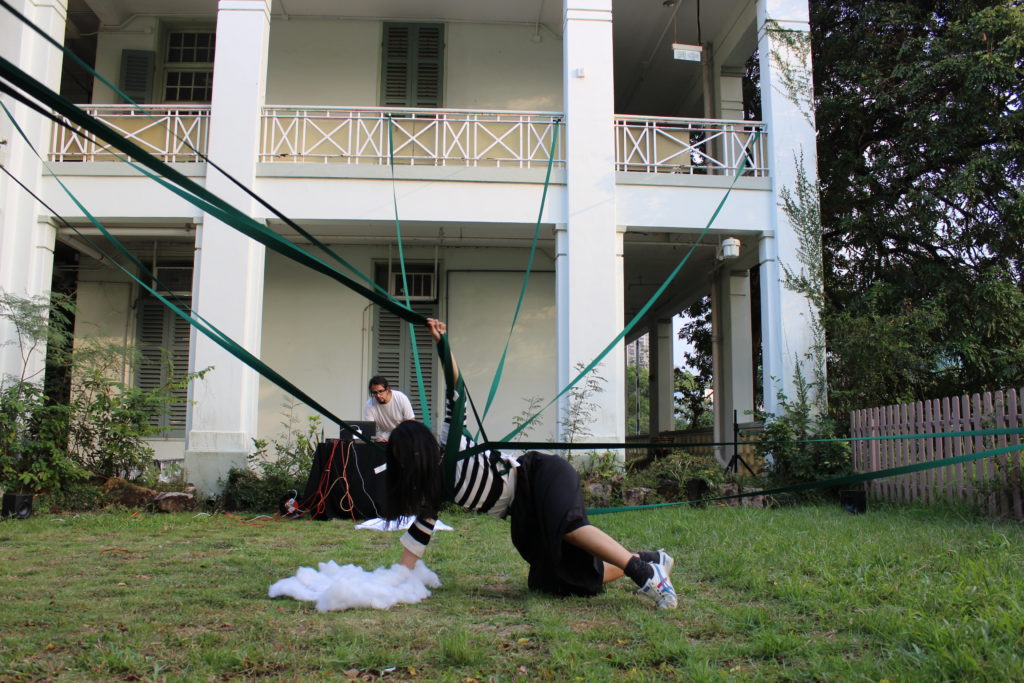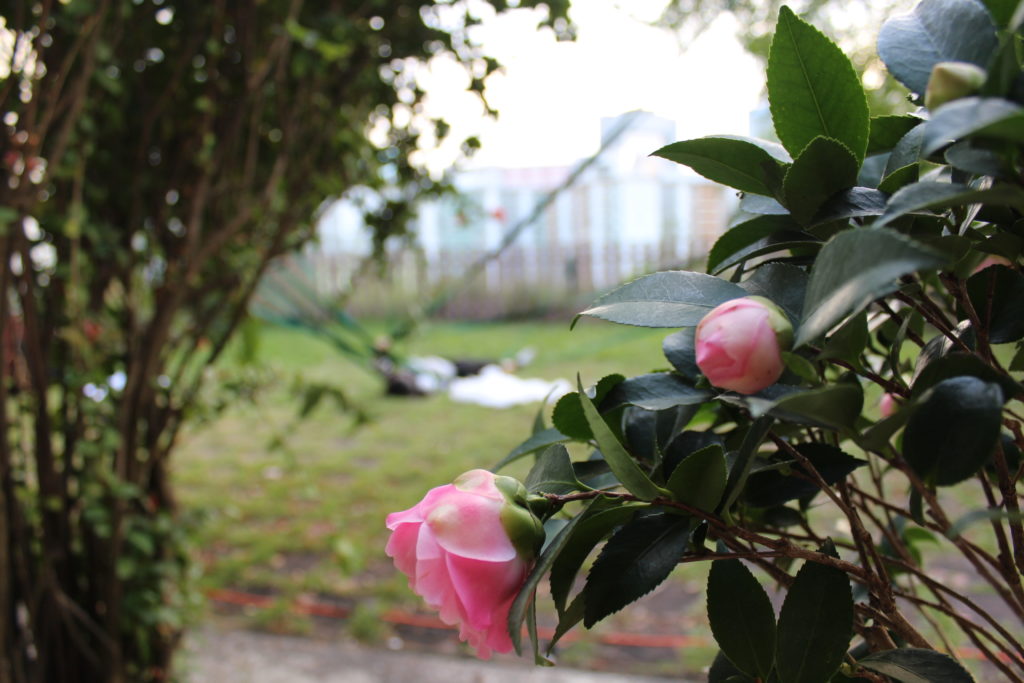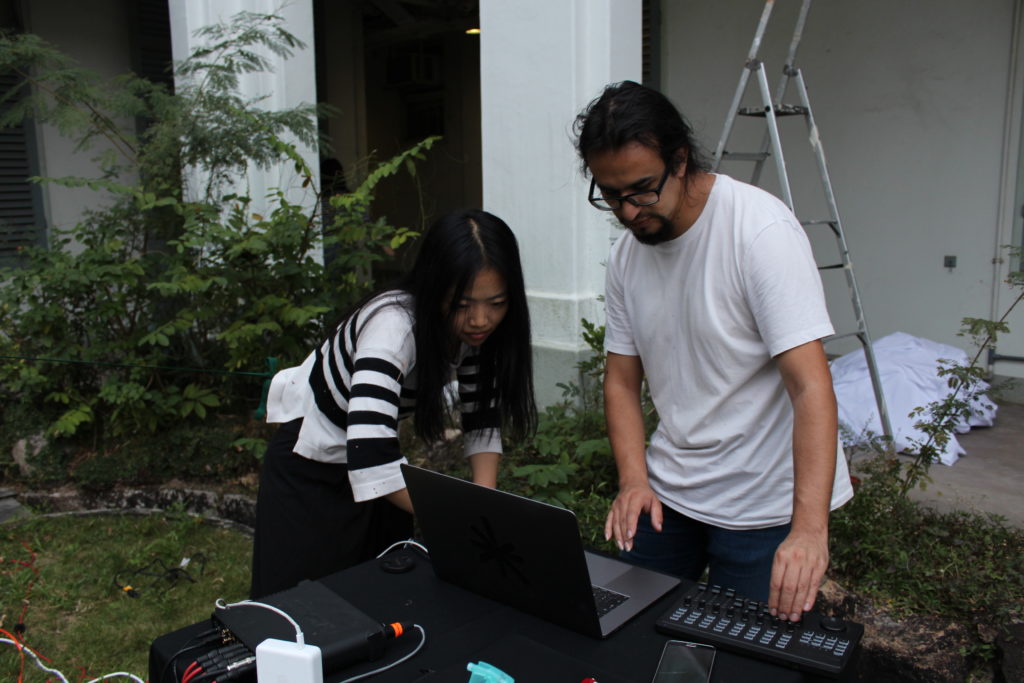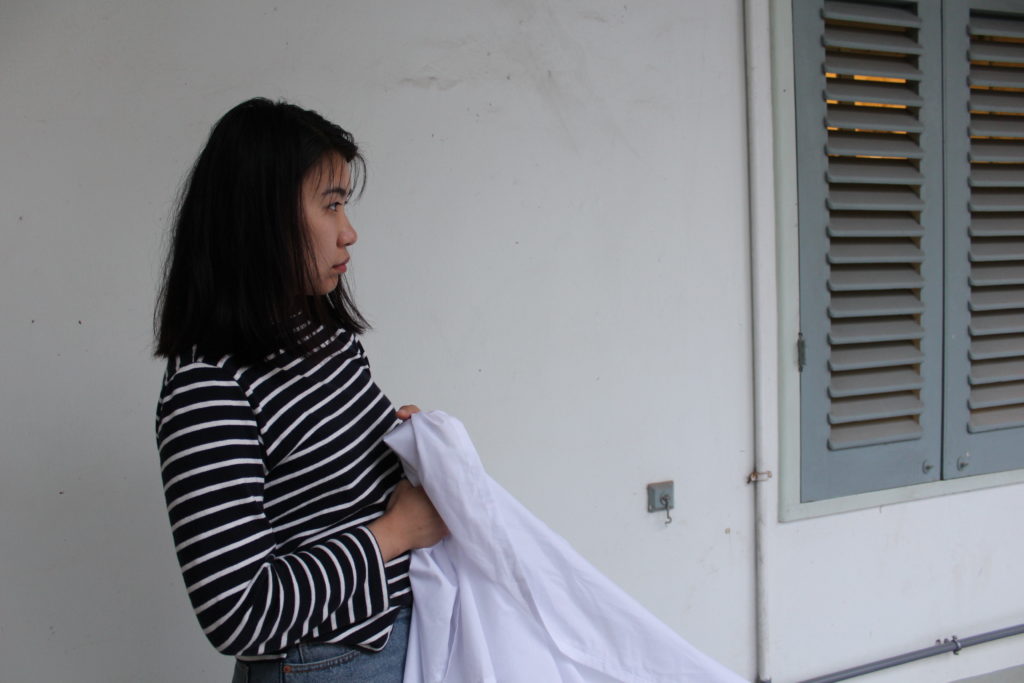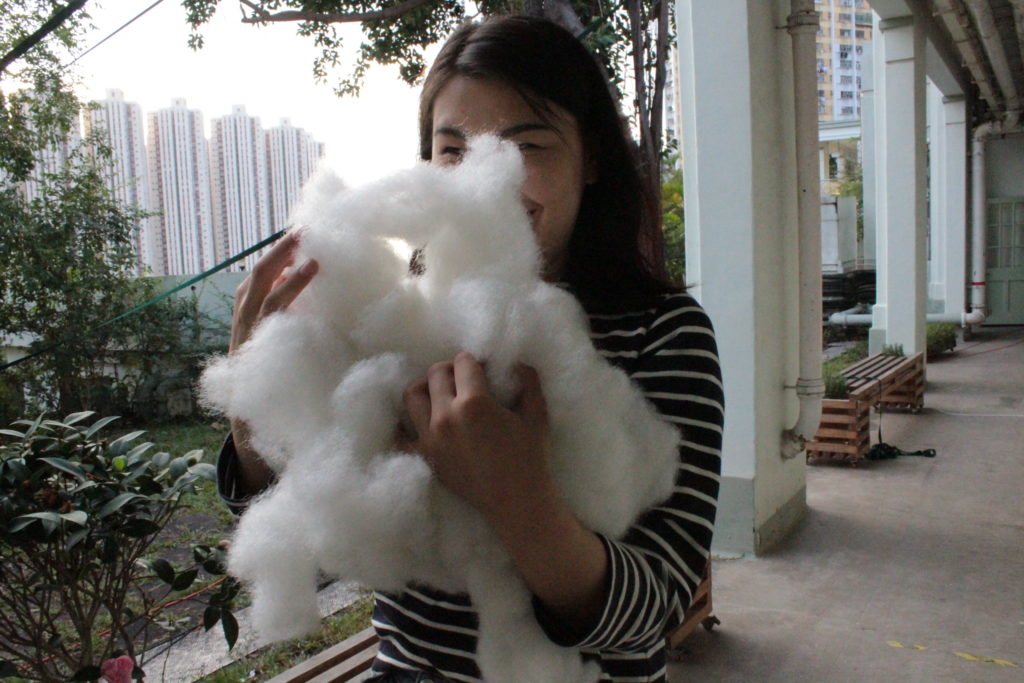For the third and last phase of this year’s programme, individual portraits of the current groups are published in order to give a glimpse into the day-to-day collaborations, convey the intensity of the work process and sketch the interplay between the individual and the collective. Today we present a day in the work of Yu Rainie Liu (art management/theatre making), José Eduardo Yépez Pino (electroacoustic composition/guitar), Xinyun Juliana Zhu (choreography/dance) the result of which will be presented in the final group exhibition 说了/ 没说 : SPOKEN / UNSPOKEN on the 24th November 2018.
I visit the smallest of the collaboration groups on a mild and sunny afternoon in the campus’ spacious garden front (with the most stunning view onto the urban landscape). They’ve installed some sort of hyperdimensional spiderweb out of dark green ropes. Xinyun Juliana Zhu is lying perfectly still and face down on the grass with her body being held by the ropes, José Eduardo Yépez Pino is standing bent over his musical equipment working the mixer and Yu Rainie Liu alertly watches the scene from the arcade. Their focus is almost tangible.
It’s already the third time that they’ve decided to work together, however for the first two times they’d formed groups with several other participants. Their trio maintained itself as a kind of hard core, one could say. As I observe their work, I quickly understand why their dynamic is a fruitful one. Liu is an organiser by heart: a woman of action who feels more comfortable backstage than in the spotlight and is fearless as well as spot-on when it comes to managing logistics, strategy and timing. Watching her collaborate in the group, she seems deeply dedicated to the cause, selfless almost, but in the programme’s plenary sessions, Liu’s often evinced a confident demeanour and firm opinions. Like Liu, Zhu was trained at the Hong Kong Academy for Performing Arts but specialising in dance and choreography. While Zhu’s been dancing for her whole life, her joy lies in working as a choreographer. She’s a profoundly sensitive, hard-working person, highly skilled in keeping everybody in good spirits and used to delivering her best. She’s astonishingly stress-resistant and, moreover, warm-hearted and generous with her disarming smile. The two women have known each other before and have even been involved in school projects together but only remotely so. They tell me that they can imagine to work together in the future.
Yépez Pino doesn’t appear to mind that his two collaborators often speak Mandarin at length without him understanding a single word. In those moments, he only seems to delve even further into his electronic experiments with drones, faraway howls and crackles that sound as if they originated directly from the rainforest. The garden lot is surrounded by four massive speakers. „In order to create a quadrophonic sound space.“, he explains. Yépez Pino has lived in many places and done a lot of different things in life, but he has always been firmly rooted in music. Although he studies electroacoustic composition, his heart beats for styles like Bossa Nova, Salsa and the Son Cubano. He perceives his field of study as a playground to juxtapose and try out a fusion of the diverging musical worlds that he professionally and personally moves through and whose borders he keeps transgressing. I notice how he attentively watches and absorbs Zhu’s dancing into his music. When asked about it, his reaction is full of passion. „That’s it!“, he says. „Everything is a dialogue but naturally it is the music that follows the dance which, for me, is how music came into being in the first place.“ He goes on to expand on his perception that first there were the rhythms of our bodies, our pulsations and intuitive movements, and that only from there the musical sounds emerged. So, sonically answering to Zhu’s dancing, Yépez Pino’s composition for this current work meanders between structure and improvisation.
The same is true for Zhu’s choreography. „I need to prepare some structures.“, she says, ceaselessly exploring the space with her moves and explaining that the choreography isn’t following a static plan but organically plays with prepared modules and gaps for improvisation. I’m amazed by how her omnipresent smile disappears as soon as she starts to dance. Almost as if the smile turned inward with all the rest of her attention and energy in order to entirely engage body and mind with the creation of Asphalt Nature. Asphalt Nature is the title of their work in the course of which they’re evoking a nature that is inhibited, restricted and increasingly strangled not only by the cement but by the relentlessly imposing urban infrastructure—a structure they accuse of being hostile to life. To develop the project, the three haven’t dealt too long with brooding over a theoretical concept but jumped right into what they all agree to be the essence of the art: the process of practice (or the practice of process?). They want their work to be genuinely dialectical. For the sake of this aim, they are constantly testing, organically elaborating and radically changing directions if perceived necessary for the further growth. „The process is hard…“, watching their exhausted smiles and hearing them talk about it, suggests just how much they’re invested in it, maybe suffer through it, „…but in a good way.“, they’re quick to add.
In that sense, their style illustrates how the development of an art work doesn’t always have to move from concept to material but can very much go the other way with the growing material perpetually feeding the concept and with deeper meaning emerging only from the work’s actual life and sensuousness. The trio spends day and night out on the grass, unafraid of late shifts or of inevitable creative crisis. Artistically, they’re in constant dialogue but speak relatively little during practice with Yépez Pino’s sound and Zhu’s movements doing most of the talking. Meanwhile, Liu makes every effort to assure a seamless continuation of the process—taking care of everything from equipment trouble to making sure her two protégés don’t forget to eat or drink. I find myself touched by the sincerity with which she fulfils her role in the collaboration. It reminds me of the fact that often even art works that seem to be complete one-wo*man-shows have got—in one way or another—devoted people like Liu at their back. When talking collaborative art, one should hands down also talk about all the top-notch background work behind the big shots and the figureheads.

